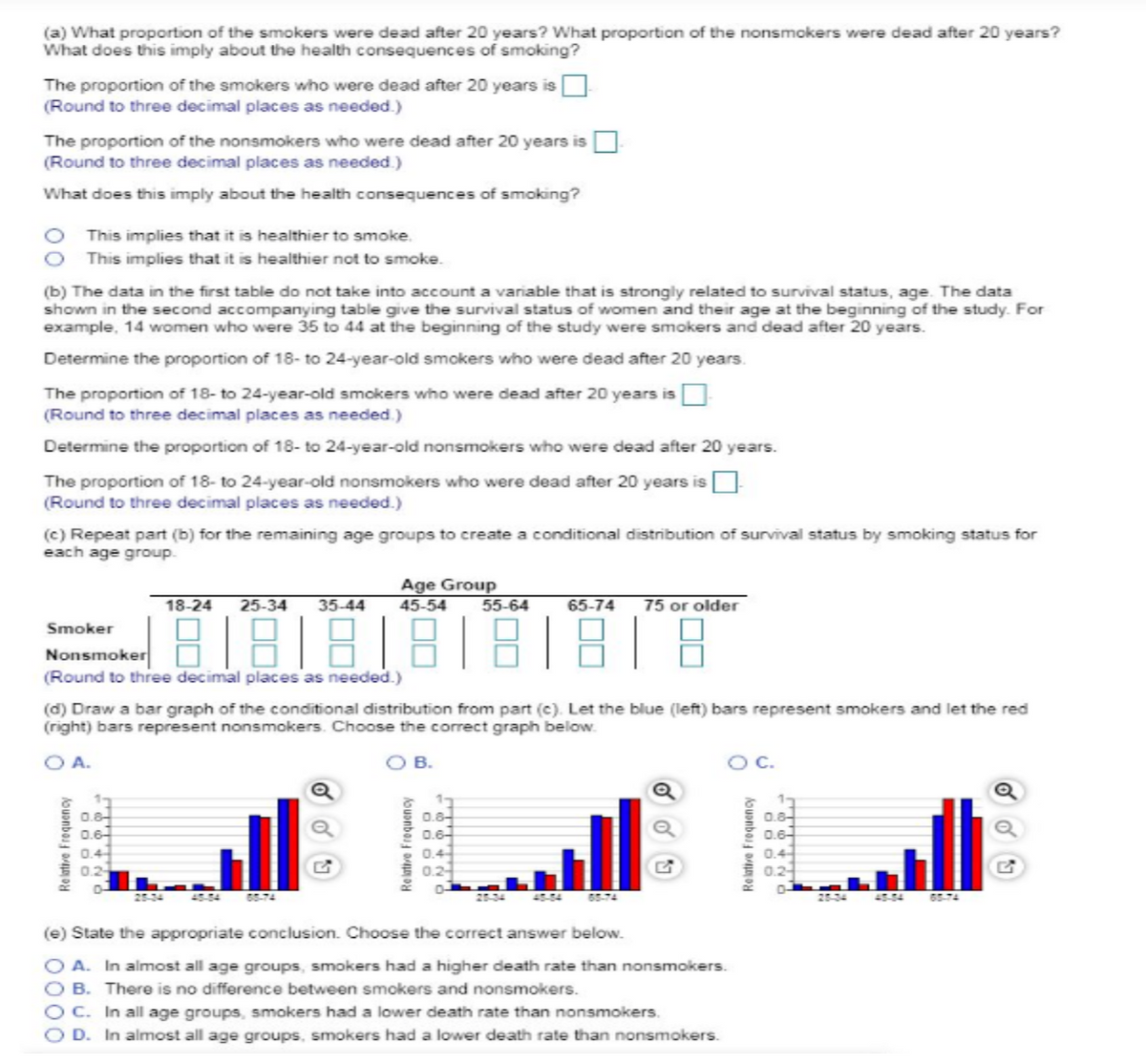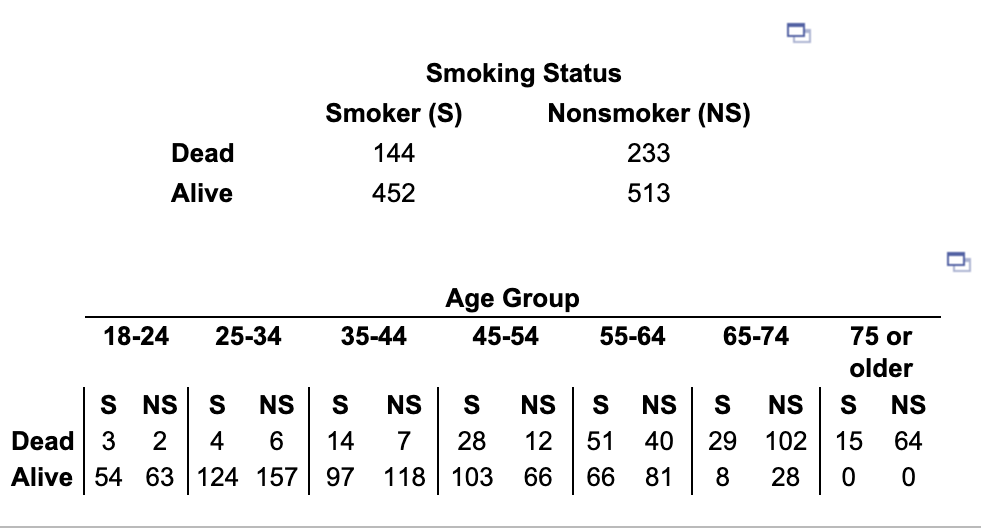(a) What proportion of the smokers were dead after 20 years? What proportion of the nonsmokers were dead after 20 years? What does this imply about the health consequences of smoking? The proportion of the smokers who were dead after 20 years is (Round to three decimal places as needed.) The proportion of the nonsmokers who were dead after 20 years is (Round to three decimal places as needed.) What does this imply about the health consequences of smoking? This implies that it is healthier to smoke. This implies that it is healthier not to smoke. (b) The data in the first table do not take into account a variable that is strongly related to survival status, age. The data shown in the second accompanying table give the survival status of women and their age at the beginning of the study. For example, 14 women who were 35 to 44 at the beginning of the study were smokers and dead after 20 years. Determine the proportion of 18- to 24-year-old smokers who were dead after 20 years. The proportion of 18- to 24-year-old smokers who were dead after 20 years is (Round to three decimal places as needed.) Determine the proportion of 18- to 24-year-old nonsmokers who were dead after 20 years. The proportion of 18- to 24-year-old nonsmokers who were dead after 20 years is (Round to three decimal places as needed.) (c) Repeat part (b) for the remaining age groups to create a conditional distribution of survival status by smoking status for each age group.
(a) What proportion of the smokers were dead after 20 years? What proportion of the nonsmokers were dead after 20 years? What does this imply about the health consequences of smoking? The proportion of the smokers who were dead after 20 years is (Round to three decimal places as needed.) The proportion of the nonsmokers who were dead after 20 years is (Round to three decimal places as needed.) What does this imply about the health consequences of smoking? This implies that it is healthier to smoke. This implies that it is healthier not to smoke. (b) The data in the first table do not take into account a variable that is strongly related to survival status, age. The data shown in the second accompanying table give the survival status of women and their age at the beginning of the study. For example, 14 women who were 35 to 44 at the beginning of the study were smokers and dead after 20 years. Determine the proportion of 18- to 24-year-old smokers who were dead after 20 years. The proportion of 18- to 24-year-old smokers who were dead after 20 years is (Round to three decimal places as needed.) Determine the proportion of 18- to 24-year-old nonsmokers who were dead after 20 years. The proportion of 18- to 24-year-old nonsmokers who were dead after 20 years is (Round to three decimal places as needed.) (c) Repeat part (b) for the remaining age groups to create a conditional distribution of survival status by smoking status for each age group.
Elementary Linear Algebra (MindTap Course List)
8th Edition
ISBN:9781305658004
Author:Ron Larson
Publisher:Ron Larson
Chapter2: Matrices
Section2.5: Markov Chain
Problem 11E: Purchase of a product The market research department at a manufacturing plant determines that 20 of...
Related questions
Question
Could it be that smoking actually increases survival rates among women? The accompanying data represent the 20-year survival status and smoking status of
1334 women who participated in a 20-year cohort study. Complete parts (a) through (e).

Transcribed Image Text:O A.
(a) What proportion of the smokers were dead after 20 years? What proportion of the nonsmokers were dead after 20 years?
What does this imply about the health consequences of smoking?
The proportion of the smokers who were dead after 20 years is
(Round to three decimal places as needed.)
The proportion of the nonsmokers who were dead after 20 years is
(Round to three decimal places as needed.)
What does this imply about the health consequences of smoking?
O This implies that it is healthier to smoke.
This implies that it is healthier not to smoke.
(b) The data in the first table do not take into account a variable that is strongly related to survival status, age. The data
shown in the second accompanying table give the survival status of women and their age at the beginning of the study. For
example, 14 women who were 35 to 44 at the beginning of the study were smokers and dead after 20 years.
Determine the proportion of 18- to 24-year-old smokers who were dead after 20 years.
The proportion of 18- to 24-year-old smokers who were dead after 20 years is
(Round to three decimal places as needed.)
Determine the proportion of 18- to 24-year-old nonsmokers who were dead after 20 years.
The proportion of 18- to 24-year-old nonsmokers who were dead after 20 years is
(Round to three decimal places as needed.)
(c) Repeat part (b) for the remaining age groups to create a conditional distribution of survival status by smoking status for
each age group.
18-24 25-34 35-44
Age Group
45-54
55-64
65-74 75 or older
Smoker
Nonsmoker
888888
(Round to three decimal places as needed.)
(d) Draw a bar graph of the conditional distribution from part (c). Let the blue (left) bars represent smokers and let the red
(right) bars represent nonsmokers. Choose the correct graph below.
Relative Frequency
0.8
0.6
0.4
0.2
O B.
Relative Frequency
0.8-
0.6-
0.4-
0.2
G
(e) State the appropriate conclusion. Choose the correct answer below.
OA. In almost all age groups, smokers had a higher death rate than nonsmokers.
OB. There is no difference between smokers and nonsmokers.
OC. In all age groups, smokers had a lower death rate than nonsmokers.
D. In almost all age groups, smokers had a lower death rate than nonsmokers.
OC.
Relative Frequency
0.8
0.6
0.4
0.2
-го
28-34
65-

Transcribed Image Text:Smoking Status
Smoker (S)
Nonsmoker (NS)
Dead
144
233
Alive
452
513
Age Group
18-24
25-34
35-44
45-54
55-64
65-74
75 or
older
S NS S
NS
S
NS
S
NS
S NS
S
NS
S NS
Dead 3 2 4 6
14
7
28 12
51
40 29 102
15 64
Alive 54 63 124 157
97
118
103 66
60
66
81
8
28
0
0
Expert Solution
This question has been solved!
Explore an expertly crafted, step-by-step solution for a thorough understanding of key concepts.
Step by step
Solved in 3 steps with 1 images

Recommended textbooks for you

Elementary Linear Algebra (MindTap Course List)
Algebra
ISBN:
9781305658004
Author:
Ron Larson
Publisher:
Cengage Learning

Functions and Change: A Modeling Approach to Coll…
Algebra
ISBN:
9781337111348
Author:
Bruce Crauder, Benny Evans, Alan Noell
Publisher:
Cengage Learning

Elementary Linear Algebra (MindTap Course List)
Algebra
ISBN:
9781305658004
Author:
Ron Larson
Publisher:
Cengage Learning

Functions and Change: A Modeling Approach to Coll…
Algebra
ISBN:
9781337111348
Author:
Bruce Crauder, Benny Evans, Alan Noell
Publisher:
Cengage Learning